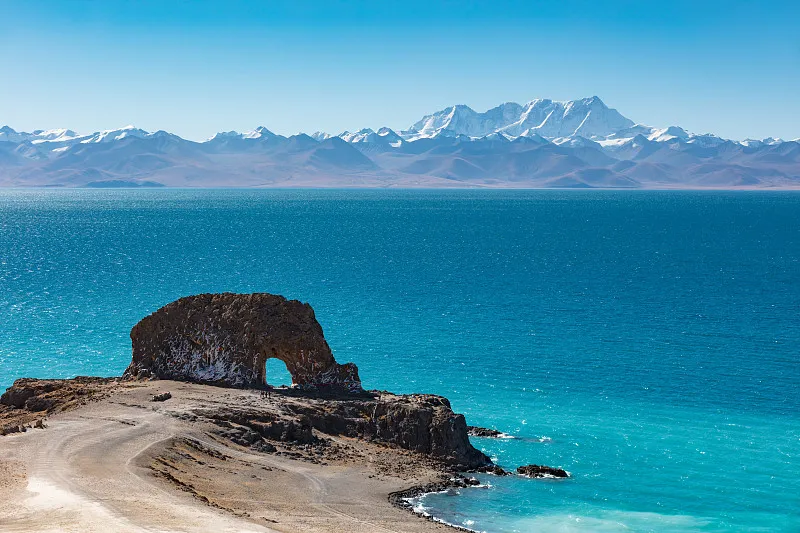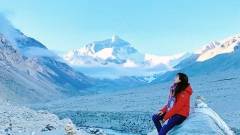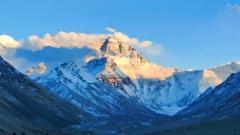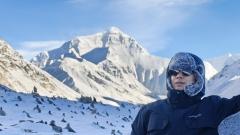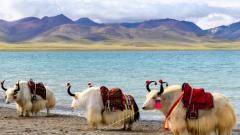The Himalayas stand as one of the most awe-inspiring mountain ranges on Earth, captivating travelers and adventurers alike with their towering peaks, rich biodiversity, and vibrant cultural tapestry. Stretching across five countries in South Asia, the Himalayas have long been synonymous with natural grandeur and spiritual significance. Before embarking on your Himalayan expedition—whether trekking through lush valleys, visiting remote villages, or simply gazing upward in wonder – it’s worthwhile to explore the region’s most compelling facts. From its linguistic origins and geological history to its climatic influence and legendary creatures, the Himalayas offer a wealth of fascinating insights that deepen one’s appreciation of this “abode of snow.”
1. The Name “Himalaya” and Its Meaning
Long before modern cartographers mapped the soaring ridges of South Asia, ancient civilizations recognized the grandeur of these mountains, bestowing upon them the name “Himalaya.” Derived from Sanskrit, “Himā-laya” translates literally to “Abode of Snow,” a fitting moniker given the perpetual ice and snow adorning the range’s summits. In Tibetan, the mountains are known as “Bam Asis,” often referred to simply as the Land of Snow, while in Chinese the term “Ximalaya” captures a similar sense of frozen majesty.
This shared linguistic thread underscores how various cultures have long revered the Himalayas not only for their physical presence but also for their spiritual resonance. For centuries, Buddhist, Hindu, and indigenous Himalayan communities have considered these high peaks sacred, believing the snowy heights to be the earthly dwelling of deities and spirits. When you travel to the Himalayas, you’re stepping into a landscape that ancient peoples viewed as a heavenly domain, where the sky seems within arm’s reach.
2. Peaks Above 8,000 Meters: The Roof of the World
One of the most remarkable features of the Himalayan range is its inclusion of ten mountains that exceed 8,000 meters (26,247 feet) in elevation. These colossal summits represent some of the most challenging and revered climbs on the planet:
- Mount Everest (8,848 m / 29,029 ft)
- Kangchenjunga (8,586 m / 28,169 ft)
- Lhotse (8,516 m / 27,940 ft)
- Makalu (8,485 m / 27,838 ft)
- Cho Oyu (8,188 m / 26,864 ft)
- Dhaulagiri (8,167 m / 26,795 ft)
- Manaslu (8,163 m / 26,781 ft)
- Nanga Parbat (8,126 m / 26,660 ft)
- Annapurna I (8,091 m / 26,545 ft)
- Shishapangma (8,027 m / 26,335 ft)
Beyond these giants, there are roughly 40 peaks soaring above 7,000 meters (22,966 feet). Collectively, these high-altitude summits earn the Himalayas the title of the highest mountain range on the planet. While summiting Everest remains unattainable for most, the mere presence of these mega-peaks draws mountaineers, photographers, and travelers who wish to witness the drama of high-altitude ice fields and steep rocky faces. Even if you’re not scaling a peak, trekking in villages at 3,000–4,000 meters affords unparalleled views of these 8,000-meter giants, reminding you of the sheer vertical scale that defines the region.
3. A 2,500-Kilometer Spine: Geography and Extent
Laid out like a colossal spine across South and Central Asia, the Himalayan range extends approximately 2,500 kilometers (1,550 miles) from west to east. At its westernmost anchor lies Nanga Parbat in Pakistan, while the eastern terminus is marked by Namcha Barwa in eastern Tibet (China). This immense expanse separates the lush, subtropical plains of the Indian subcontinent to the south from the high-altitude Tibetan Plateau to the north.
In terms of width, the Himalayas fluctuate between 200 and 300 kilometers (125–185 miles) from north to south. To the north, the Himalayas are bordered by the Karakoram and Hindu Kush ranges—older, equally formidable formations—while the southern boundary gently descends into the fertile Indo-Gangetic Plain. Between the Tibetan Plateau and the southern flanks lies the Indus-Tsangpo Suture Zone, a fault valley up to 60 kilometers wide where the ancient Tethys Ocean once lay concealed. Today, this same suture marks the collision line where the Indian Plate thrust under the Eurasian Plate, giving rise to the towering Himalayas.
For the modern traveler, this geographic layout means that a single Himalayan journey can encompass arid highlands, tropical foothills, and sprawling valleys, all within a few days’ travel. Whether you begin in Nepal’s lush Kathmandu Valley or cross into India’s Darjeeling district, you’ll quickly sense how the landscape morphs from dense forests to rocky ridges as elevation gains ground.
4. From Tethys Ocean to Titantic Mountain Range: Geological Origins
Contrary to what one might assume, the Himalayas did not always exist as rugged peaks pushing skyward. Roughly 70 million years ago, the region that is now the Himalayas was part of the Tethys Ocean, an expansive sea separating the ancient continents of Gondwana and Laurasia. As tectonic dynamics played out, the Indo-Australian Plate began a slow northward drift, ultimately colliding with the Eurasian Plate around 50 million years ago.
The immense pressure and friction at this convergent boundary caused layers of marine sediments, including fossilized limestone rich with ancient sea life, to buckle and fold. These sedimentary rocks were literally lifted from below sea level to form the nascent peaks of the Himalayas. Even today, climbers on Mount Everest occasionally find fossilized shells near the summit—powerful evidence that this “roof of the world” once lay beneath a prehistoric ocean. Over millions of years, erosion and glacial activity sculpted the peaks into the dramatic ridges and cirques we observe now.
This ongoing tectonic uplift continues today: measured at approximately 5–8 millimeters per year, the Himalayas remain one of the most geologically active zones on Earth. You may not feel the plates shifting underfoot, but every seismic tremor in Nepal, Bhutan, or northern India is a reminder that these mountains are not merely ancient—they are still very much alive.
5. Climate Architect: How the Himalayas Shape South Asian Weather
From the tropical coasts of India to the high arid plateaus of Tibet, the Himalayas play a pivotal role in determining the climate and rainfall patterns of millions. One of the most significant effects is their influence on the South Asian monsoon. During the summer months (June through September), warm air masses from the Indian Ocean surge northward, colliding with the sharp elevation gain of the southern Himalayan slopes. As this moist air rises, it cools and releases its moisture as heavy rainfall across northern India, Nepal, and Bhutan—often resulting in lush, emerald-green valleys and terraced rice fields throughout the lower Himalayas.
Conversely, the lofty barrier of the mountains blocks this monsoonal moisture from reaching the Tibetan Plateau, casting a literal “rain shadow” over the highlands. As a result, Tibet experiences arid, continental conditions, with scant precipitation and stark temperature swings. In essence, the southern slopes of the Himalayas teem with vegetation thanks to abundant monsoonal rain, while the northern slopes remain relatively dry, punctuated by scrubland and desert-like expanses at higher altitudes.
This climatic divergence fosters a diverse array of ecosystems within relatively short distances. In the foothills, subtropical jungles are home to barking deer and colorful pheasants; higher up, pine and rhododendron forests transition to alpine meadows dotted with wildflowers; and above 5,000 meters, permanent snowfields and glaciers dominate the skyline. For travelers, understanding this climatic interplay is crucial when planning lodging, acclimatization, and cultural excursions—whether you’re exploring tea gardens in Darjeeling or monasteries above the arid valleys of Tibet.
6. The Cradle of Nineteen Major Rivers
Often hailed as the “water towers” of Asia, the Himalayas serve as the headwaters for at least nineteen major rivers that nourish the continent’s fertile plains and support hundreds of millions of people. The slow melt of snow and glaciers across these lofty summits feeds perennial rivers that traverse diverse terrains before emptying into distant seas. Key rivers originating here include:
- Indus River: Winding through Pakistan before reaching the Arabian Sea, the Indus nourishes the Punjab region, supporting one of the world’s oldest agrarian civilizations.
- Ganges River (Ganga): Revered as holy by Hindus, the Ganges begins in the Uttarakhand region of India and flows through the fertile Gangetic Plain, before ending in the Bay of Bengal.
- Yarlung Tsangpo (Brahmaputra): Rising in southwestern Tibet (China), it courses eastward before making a dramatic U-turn (the Great Bend) to flow into India and Bangladesh.
Beyond these three, rivers such as the Kosi, Karnali, Teesta, and Subansiri also emerge from Himalayan glaciers, each carving its own path through gorges and plains. These waterways underlie the agricultural heartlands of northern India, Bangladesh, Nepal, and Pakistan. They provide essential irrigation, hydroelectric power, and freshwater to countless communities.
As global warming accelerates glacier melt, the long-term sustainability of these rivers is under threat. Yet for today’s traveler, witnessing Himalayan rivers—from roaring rapids used for whitewater rafting in Nepal to serene ghats along the Ganges—offers insight into how mountain hydrology shapes entire civilizations.
7. Climate and Weather: From Temperate Valleys to Glacial Peaks
The Himalayas encompass an extraordinary range of climatic zones, dictated not just by latitude but by dramatic changes in elevation. On the southern slopes, subtropical climates prevail at lower altitudes (1,000–2,000 meters), where average summer temperatures hover around 20°C (68°F) and winter temperatures dip to roughly 5–10°C (41–50°F). Higher elevations (2,500–4,000 meters) transition into temperate and subalpine climates, characterized by cooler summers (10–15°C / 50–59°F) and frigid winters that plunge below freezing.
Above 5,000 meters, in the alpine and nival zones, temperatures remain below zero year-round, and snowfields and glaciers dominate the landscape. Here, oxygen levels become as thin as half of what’s available at sea level, posing a serious challenge for the unacclimatized traveler. It’s this stark range—from verdant valleys to lifeless summits—that defines why the Himalayas have captivated explorers throughout history.
One of the best ways to experience these shifts is to time your trip carefully. On the southern side, visitors can generally enjoy mild, sunny weather from April to October—peak season for trekking in Nepal and India. In contrast, the northern Tibetan regions are best explored between May and September, when snow has melted enough to open high passes. Bhutan’s ideal window falls between October and December, when post-monsoon skies clear and rhododendron blooms adorn the hillsides.
Despite these guidelines, weather in the Himalayas can be notoriously unpredictable. Afternoon cloud build-up may obscure mountain vistas. A sudden cold front can blanket a pass in snow. Therefore, travelers should always carry layered clothing, waterproof gear, and reliable local guidance to navigate rapidly shifting conditions.
8. Over 50 Million Inhabitants and a Tapestry of Cultures
The Himalayas are not merely an expanse of uninhabited wilderness; they are home to more than 50 million people residing in villages, towns, and cities scattered throughout the range. This population comprises a mosaic of ethnicities—Aryans, Mongoloids, and various indigenous groups—each contributing to a rich cultural fabric woven over millennia.
Beyond those who live on the slopes themselves, nearly 600 million people dwell within the fertile river basins fed by Himalayan meltwater, including the Gangetic Plain and Indus Valley. For these downstream communities, the Himalayas’ snow and ice are not just majestic scenery but vital lifelines.
Within the mountains, cultural influences vary dramatically from north to south. On the northern Tibetan side of Everest, Tibetan Buddhism shapes daily life; prayer flags flutter atop rocky ridges, while monks chant in remote gompas (monasteries). In the middle Himalayan valleys, cultural traditions often resemble those found in Afghanistan and Iran, with distinct architectural styles—stone houses, flat roofs, and ornate wood carvings. In Nepal’s mid-hills, Hindu festivals blend seamlessly with Buddhist practices, as travelers pass through vibrant bazaars and centuries-old temples.
Religious diversity also plays a key role. Hinduism, Buddhism, and various animistic practices coexist, frequently within the same village. Festivals such as Losar (Tibetan New Year), Dashain (Nepal’s biggest Hindu festival), and Tij (a women’s festival in Uttarakhand and Nepal) punctuate the cultural calendar, offering visitors a window into ancient customs. When planning a Himalayan adventure, consider timing it to coincide with local festivals—an immersive way to gain insight into the region’s peoples and traditions.
9. Wildlife Haven: More Than 300 Animal Species
Despite the harsh conditions at high elevations, the Himalayas support an incredible variety of wildlife – over 300 species of mammals and countless birds, reptiles, fish, and amphibians. Each altitude band offers a distinct habitat: lower slopes may be cloaked in subtropical forests alive with langurs and hornbills, while higher ridges and cliffs shelter elusive, cold-adapted species.
In the subalpine zones (3,000–4,000 meters), you might spot Himalayan marmots, whose burrows pockmark grassy meadows. Blue sheep (bharal) navigate steep, rocky slopes between 4,000 and 6,000 meters, employing their milky-blue coats as camouflage against predators such as the snow leopard – one of the range’s most iconic, yet endangered, inhabitants. The Himalayan region is also home to the wild yak, a formidable bovine perfectly suited to extreme cold, and the elegant Himalayan tahr, whose curved horns make it an attractive sight on forested hillsides.
Smaller mammals, such as the musk deer, have faced significant hunting pressure due to the demand for musk pods, leading to dwindling populations. Additionally, two bear species—the Himalayan brown bear and Himalayan black bear – roam the range, although sightings remain rare. Birdlife is equally diverse: blood pheasants, monal pheasants, and Himalayan griffon vultures soar overhead.
At the highest reaches – above 5,500 meters – few creatures can endure the freezing temperatures and scarce oxygen. Yet even in this so-called “third pole” of the Earth, life persists in hardy forms, primarily within microbial communities beneath the ice. For wildlife enthusiasts, organized safaris and birdwatching treks in national parks like Nepal’s Sagarmatha National Park, India’s Hemis National Park, and Bhutan’s Jigme Singye Wangchuck National Park offer the best chances of encountering these rare species.
10. Distinguishing the Himalayas from Mount Everest
A common misconception is that “the Himalayas” and “Mount Everest” are interchangeable terms. In reality, the Himalayas refer to an entire mountain system encompassing numerous peaks, valleys, and subranges that span five nations—India, Nepal, China (Tibet), Bhutan, and Pakistan. Mount Everest (known locally as Sagarmatha in Nepali and Chomolungma in Tibetan) is merely one of the thousands of peaks within this vast complex.
Standing at 8,848 meters (29,029 feet), Everest holds the distinction of being the highest point on Earth, marking the border between Nepal and the Tibet Autonomous Region of China. But for every hiker who dreams of gazing up at Everest’s snow-draped summit, countless others trek through regions of the Himalayas that are far less crowded—such as the Annapurna Circuit in Nepal or the Markha Valley in India’s Ladakh region.
It’s important to remember that while Everest often steals headlines, the Himalayas’ grandeur is defined by the collective awe of its many summits and landscapes. From the verdant lower hills to the arid Changtang Plateau, the entire Himalayan system is more than the sum of its parts. By venturing beyond Everest-centric itineraries, travelers can uncover hidden monasteries, interact with unique cultures, and witness spectacular mountain vistas that rival those found on the world’s tallest peak.
11. A Transnational Frontier: No Single Owner
Spanning multiple international borders, the Himalayas are a shared heritage that does not belong to any one nation. The range runs along the edges of India, Nepal, Bhutan, Pakistan, and China. On a map, you can trace the Himalayan arc:
- In the west, Pakistan’s Karakoram range merges with the far-flung peaks of Nanga Parbat, sometimes called the “Killer Mountain” for its challenging ascents.
- Moving eastward, the range forms much of the northern border of India (states like Jammu & Kashmir, Himachal Pradesh, Uttarakhand, Sikkim, and Arunachal Pradesh).
- Across the middle section, Nepal occupies a significant slice of the central Himalayas, boasting eight of the ten highest peaks in the world.
- Further east, Bhutan’s less-visited but profoundly spiritual mountains close the corridor before it reconnects with China’s Tibet Autonomous Region, where the range begins its descent toward the plains.
This multinational distribution has both advantages and challenges. On the one hand, it allows for a rich tapestry of cultural exchanges—pilgrimages, trade routes, and shared spiritual traditions. On the other hand, geopolitical sensitivities sometimes restrict movement; permits, visas, checkpoints, and regional regulations vary widely from one country to the next. For travelers, awareness of these border dynamics is essential. A popular example is the choice between the South Face route (Nepal side) and the North Face route (Tibet side) when seeking a view of Mount Everest. Each offers a distinct cultural lens: Sherpa villages and Buddhist monasteries in Nepal, versus Tibetan plateaus and ancient pilgrim trails in Tibet.
12. The Yeti: Myth or Mystery?
Lost in the mists of Himalayan superstition is the enduring legend of the Yeti – a supposed ape-like creature often called the “Abominable Snowman.” According to local lore, the Yeti roams the snowy passes between Nepal, Bhutan, and Tibet, leaving behind enormous footprints in fresh snow. Sightings and anecdotal reports date back centuries, though they gained international attention in the late 19th and early 20th centuries as British mountaineers returned from expeditions with stories of strange tracks and eerie howls echoing through the high Himalayan valleys.
Despite numerous expeditions and modern scientific investigations—including DNA analysis of purported hair samples—conclusive proof of the Yeti’s existence remains elusive. Some researchers claim that footprints attributed to the Yeti are actually those of Himalayan brown bears, whose tracks can appear humanoid in melting snow. Others suggest that local shamans and community elders perpetuate the Yeti myth as part of a broader spiritual tradition, viewing the creature as a guardian spirit or portent of natural imbalance.
Yet for many visitors, the allure of the unknown adds a layer of mystique to their Himalayan journey. Tea houses in Solu-Khumbu (the Everest region) often display plaster casts of alleged Yeti footprints. Villagers in remote Bhutanese valleys may produce scraggly tufts of “Yeti hair” as souvenirs. Whether you believe the Yeti is a cryptid yet to be discovered or simply a captivating story passed down through generations, the legend remains one of the most intriguing facets of Himalayan lore.
13. Best Seasons to Explore the Himalayas
While region-specific travel windows were mentioned in earlier sections, it’s worth summarizing the optimal seasons to experience the Himalayas’ full splendor:
- Nepal: For trekking in regions like Everest, Annapurna, and Langtang, the pre-monsoon (February–April) and post-monsoon (late September–November) periods are ideal. These months offer stable weather, clear skies, and blossoming rhododendrons.
- India (Himachal Pradesh, Uttarakhand, Sikkim): Spring (March–June) brings mild temperatures and colorful flora; Autumn (September–November) provides crisp air and excellent visibility of higher peaks.
- Bhutan: October–December is peak season, with cool days and clear skies ideal for trekking and cultural festivals. The monsoon (June–September) makes lower trails muddy, while winter (January–February) can be freezing at higher elevations.
- Tibet (Tibetan Plateau): Travel from May to September when snow has melted enough to open major passes, and days are long and bright. Winters are frigid, often dropping below -20°C (-4°F).
Regardless of where you go, always prepare for sudden weather changes: afternoon thunderstorms, hailstorms at mid-elevations, or unseasonal snowfalls. Carry appropriate gear—windcheaters, insulated layers, and sturdy waterproof boots—to ensure comfort and safety as you ascend or traverse passes.
14. Human Adaptations: Life at High Elevations
Living in the Himalayas presents unique physiological challenges. At altitudes above 3,500 meters, oxygen levels drop to roughly 60–65% of what’s available at sea level. Over generations, local populations have evolved remarkable adaptations:
- Increased red blood cell counts and hemoglobin levels enable more efficient oxygen transport.
- Enhanced lung capacity allows villagers to breathe more deeply and withstand hypoxic conditions.
- Genetic variations in genes such as EPAS1 (linked to oxygen sensing) are more prevalent among Tibetans and other high-altitude groups.
For the traveler, acclimatization is key. Ascending gradually, spending one or two nights at intermediate altitudes, and drinking plenty of water can mitigate acute mountain sickness (AMS). Symptoms such as headaches, nausea, or dizziness often resolve with proper rest, but severe cases require immediate descent to lower elevations. That said, witnessing how Himalayan communities have thrived at elevations above 4,000 meters offers insight into humanity’s adaptability; villages like Lhasa (Tibet) and Namche Bazaar (Nepal) buzz with life, serving as hubs for both trade and Tibetan Buddhism.
15. Cultural Treasures: Monasteries, Temples, and Festivals
Beyond its natural wonders, the Himalayas are a cradle of cultural and spiritual heritage. From the ornate Potala Palace in Lhasa to the cliffside Tiger’s Nest Monastery (Paro Taktsang) in Bhutan, sacred sites attract pilgrims and tourists alike. Each region’s religious architecture reflects unique artistic traditions:
- Nepal: In the Kathmandu Valley, centuries-old pagodas and Shikhara-style temples house Hindu deities like Pashupatinath and Buddhist shrines such as Swayambhunath (Monkey Temple).
- Tibet: High-altitude gompas (monasteries) like Tashilhunpo and Khokhang exhibit intricate murals, mandalas, and gilded Buddha statues.
- India (Sikkim, Himachal Pradesh): Colorful chortens (stupas), prayer wheels, and large Tibetan monasteries—for example, Rumtek in Sikkim—symbolize the fusion of local and Tibetan Buddhist influences.
- Bhutan: Known as the “Land of the Thunder Dragon,” Bhutan’s fortress monasteries (dzongs), such as Punakha Dzong and Trongsa Dzong, combine administrative and religious functions, standing as centers of culture and governance.
Festivals like Losar (Tibetan New Year), Holi (Festival of Colors) in Indian Himalayan states, and Tshechu in Bhutan bring these communities to life with masked dances, traditional music, and vibrant attire. The timing of these festivals often aligns with lunar calendars, so dates shift annually. Attending a local festival can be a highlight of any Himalayan excursion, offering travelers a front-row seat to centuries-old rituals and communal celebrations.
16. Adventure Activities: Beyond Trekking
Although trekking remains the quintessential Himalayan activity, the range offers an array of adventure options for thrill-seekers and nature lovers alike:
- Mountaineering: Beyond the famed 8,000-meter giants, numerous peaks within the 5,000–6,500-meter range provide technical, yet accessible, climbing experiences. Popular climbs include Island Peak (6,189 m) and Mera Peak (6,476 m) in Nepal.
- Whitewater Rafting: Rivers such as the Bhote Koshi and Sun Kosi in Nepal offer graded rapids from II to V, attracting paddlers worldwide. In India’s Uttarakhand, the Ganga at Rishikesh is a renowned rafting destination.
- Mountain Biking: High-altitude single-track trails, especially in Ladakh and Himachal Pradesh, challenge riders with rugged terrain and thin air. The legendary Manali–Leh highway has become a bucket-list route for cyclists.
- Paragliding: From vantage points like Pokhara (Nepal) and Bir Billing (India), paragliders soar over valleys, enjoying breathtaking panoramas of snow-dusted peaks.
- Skiing and Snowboarding: In India’s Gulmarg and Auli, powdery slopes beckon winter sports enthusiasts, with lifts ascending above 3,000 meters.
- Wildlife Safaris: National parks such as Kaziranga (Assam, India) and Chitwan (Nepal) lie at the Himalayan foothills, offering safaris to see one-horned rhinos, elephants, and Bengal tigers.
These diverse pursuits allow travelers to engage with the Himalayas on multiple levels—whether you prefer soaring above valleys as a paraglider or rafting through roaring whitewater on a jungle-bordered river.
17. Flora and Biodiversity: From Subtropical Forests to Alpine Meadows
Flanking the southern edge of the range, subtropical forests teem with life. Sal (Shorea robusta) and oak (Quercus spp.) trees create lush canopies populated by langurs, deer, and a mosaic of bird species. As you ascend into the temperate zone (2,000–3,000 meters), you encounter rhododendrons, magnolias, and pines, their blooms painting hillsides in shades of pink, red, and white come springtime.
Higher still, in the alpine zone (3,000–4,000 meters), grasslands carpet wide plateaus, bursting with wildflowers such as edelweiss and gentians. It’s here that Himalayan marmots and blue sheep forage, while soaring Himalayan griffon vultures ride on updrafts. The elevation band between 4,000 and 5,000 meters supports stunted shrubs—juniper, rhododendron nivale, and juniperus indica—all adapted to harsh winds and thin soils.
Above 5,000 meters, vegetation vanishes into lichens and cold-resistant mosses, clinging to bare rock. Despite these extreme conditions, microscopic life endures, playing a critical role in nutrient cycling and glacier ecosystems. Conservationists have raised alarms about the rapid retreat of glaciers—often called “the third pole”—and the cascading impact on water security downstream. Initiatives across Nepal, India, and Bhutan aim to protect fragile habitats and biodiversity through national parks, community-based conservation, and ecotourism that channels revenue back to local communities.
18. Cultural Connections: Pilgrimages, Trade, and the Silk Road
The Himalayas have long served as a crossroads of commerce and spirituality. Ancient trade routes—somewhat parallel to the famed Silk Road—converged at high passes like Burzil Pass and Nathu La, linking Tibet with Kashmir, Ladakh, and beyond. Salt, yak wool, medicinal herbs, and precious stones once traveled these rugged trails, forging economic and cultural ties between distant kingdoms. Today, vestiges of these caravan routes remain in the form of dilapidated mule tracks, crumbling caravanserais (inns), and stories preserved by local elders.
Pilgrims have journeyed through these passes for centuries, seeking blessings at sacred sites such as Mount Kailash in Western Tibet, considered the spiritual center of the world in Hinduism, Buddhism, Jainism, and Bon tradition. The circumambulation (parikrama or kora) around Kailash, a grueling 52-kilometer trek at altitudes above 5,000 meters, draws devotees who believe the circuit’s completion ensures spiritual purification. Although only the most experienced travelers attempt this pilgrimage, the sense of devotion and community found along the trail is legendary.
Beyond Kailash, other pilgrimage destinations such as the Nanda Devi sanctuary in India and the Tiger’s Nest in Bhutan continue to attract both spiritual seekers and cultural enthusiasts. By exploring ancient monasteries, attending pujas (prayer rituals), and conversing with local monks or lamas, travelers gain a deeper understanding of how the Himalayas have shaped philosophical thought and religious practice across South Asia.
19. Environmental Challenges: Glacial Retreat and Conservation Efforts
In recent decades, the Himalayas have become a focal point for climate scientists studying glacial dynamics and water security. Rapid warming has accelerated the melting of glaciers that feed Asia’s major rivers, threatening water supplies for millions downstream. The Gangotri Glacier in Uttarakhand, for instance, has receded by several kilometers over the past century, altering the flow of the Ganges River during dry seasons.
Deforestation, unplanned tourism, and overgrazing have further stressed fragile ecosystems. Increased pilgrimage and trekking traffic near holy sites like Mount Kailash and Everest Base Camp have necessitated stricter waste management and regulations to reduce plastic pollution and human waste. Governments and NGOs across Nepal, India, Bhutan, and Tibet have implemented measures such as eco-friendly permits, mandatory porter and sherpa training on waste handling, and community-based conservation projects that involve local villagers in afforestation and wildlife monitoring.
For travelers, being an eco-conscious guest means minimizing plastic use, carrying reusable water bottles, and adhering to “Leave No Trace” principles. Opting for locally owned lodges and hiring guides from nearby communities not only supports sustainable livelihoods but also fosters a deeper connection to the Himalayan people who serve as custodians of this remarkable landscape.
20. Culinary Traditions: From Butter Tea to Dal-Bhat
No Himalayan journey is complete without savoring the region’s distinctive culinary flavors—often dictated by altitude, local agriculture, and cultural influences. In Tibet, butter tea (po cha) stands as a staple beverage, combining tea leaves with yak butter and salt to boost calories and ward off the cold. Meals frequently feature tsampa (roasted barley flour) and hearty stews filled with yak meat, potatoes, and root vegetables.
Across the Nepalese mid-hills, the ubiquitous dal-bhat-tarkari (lentil soup served with rice and vegetables) powers trekkers on multi-day journeys. In India’s Himalayan states, dishes like thukpa (noodle soup), momos (dumplings), and sattu (roasted gram flour) offer comfort and warmth. Bhutan’s cuisine showcases ema datshi—a fiery concoction of chilies and cheese—alongside subtle delights such as buckwheat pancakes and dry red rice.
Food in the Himalayas is more than sustenance; it’s a reflection of resilience. Growers cultivate barley, buckwheat, and potatoes on terraced slopes; herders tend yaks and goats in highland pastures; and foragers collect wild mushrooms, medicinal herbs, and honey from alpine meadows. Sampling local delicacies not only nourishes the body but also provides cultural insight, connecting travelers to centuries-old agricultural and pastoral traditions.
21. Infrastructure and Accessibility: Roads, Railways, and Air Travel
While the Himalayas were once accessible only via mule trails and footpaths, modern infrastructure has greatly expanded entry points. High-altitude highways such as the Kathmandu–Lhasa highway (via Kodari Pass) and India’s Leh–Manali highway now allow overland travel between countries, although they remain closed for several months each year due to heavy snowfall. Tunnel projects like India’s Atal Tunnel (under Rohtang Pass) have shortened driving times, opening remote valleys to tourism and trade.
Air travel has also revolutionized access. Airports like Tribhuvan International (Kathmandu), Paro (Bhutan), and Lukla (Nepal) serve as gateways to highland regions, though flights often face delays due to unpredictable mountain weather. In India, regional airports such as Guwahati (Assam) and Bagdogra (West Bengal) connect to domestic and international destinations, facilitating day trips to foothill towns like Darjeeling and Gangtok.
Railway ventures seek to bridge the remote Himalayan fastness with major urban centers. India’s Karnaprayag–Rishikesh railway (under construction) and Siliguri–Darjeeling Himalayan Railway (a UNESCO World Heritage site) illustrate the daunting engineering challenges and cultural significance of connecting mountain communities. As infrastructure improves, travelers enjoy greater comfort and convenience—but must also remain mindful of balancing development with environmental stewardship.
22. Iconic Treks Beyond Everest
While Everest Base Camp remains among the most-visited trekking routes, the Himalayas boast an array of lesser-known trails that offer solitude and diverse landscapes. Consider these notable alternatives:
- Annapurna Circuit (Nepal): Traversing altitudes from subtropical lowlands to alpine deserts, this classic loop around the Annapurna Massif provides a cross-section of Nepali culture, from Gurung villages to high-mountain passes exceeding 5,400 meters.
- Markha Valley Trek (India, Ladakh): This trail guides trekkers through starkly beautiful deserts and lush river valleys, culminating in the majestic vistas of Kongmaru La (5,200 m) pass.
- Snowman Trek (Bhutan): Widely considered one of the most challenging treks in the world, it crosses multiple passes above 5,000 meters, linking remote valleys and offering glimpses of endangered wildlife such as the red panda.
- Roopkund Trek (India, Uttarakhand): Treading to a glacial lake surrounded by remains of ancient travelers, the trek through rhododendron forests and alpine meadows combines natural allure with archaeological intrigue.
- Manaslu Circuit (Nepal): Lesser-crowded than Annapurna, this trek encircles Mount Manaslu (8,163 m), passing through Himalayan hamlets and towering mani walls, with a high point at Larkya La Pass (5,106 m).
These routes provide alternatives for those who wish to bypass the crowds and discover hidden corners of the Himalayas, each trail weaving through unique cultural zones, ecological habitats, and geological formations.
23. Spiritual Journeys: Meditation, Yoga, and Monastic Retreats
Amid the Himalayas’ dramatic scenery, spiritual seekers find ample opportunities for introspection and growth. Some travelers opt for meditation retreats in tranquil monasteries perched on high ledges, dedicating weeks or even months to silent contemplation. Locations such as Tengboche Monastery in Nepal provide guided meditation sessions led by resident lamas, set against panoramic views of Everest.
The mountain range also serves as a backdrop for yoga and wellness retreats. Centers in the foothills—around Rishikesh (India) and Pokhara (Nepal)—offer courses that blend modern asanas with ancient Himalayan breathing practices, emphasizing holistic health and mental clarity. In Bhutan, Phobjikha Valley hosts secluded retreats where visitors can engage in mindfulness walks, traditional healing rituals, and conversations with Buddhist scholars.
Even if you’re not inclined toward a week-long silent retreat, simply practicing morning yoga on a balcony overlooking soaring peaks, or joining a short meditation session at a local gompa (monastery), can profoundly enhance your Himalayan experience. The sense of tranquility that arises when you align your breath with the rhythm of mountain winds is a testament to the range’s power to foster inner peace.
24. Language and Literature: Himalayan Voices
The Himalayas have inspired countless poets, writers, and historians who sought to capture their mystique. Gyaru Sherpa’s memoir “Road to Tawang” delves into the author’s life at high altitude, weaving personal narrative with Tibetan Buddhist philosophy. William Dalrymple’s travelogues recount the cultural crossroads he encountered on pilgrimage trails. In India, the works of Ruskin Bond evoke the charm of Himalayan foothill towns like Mussoorie and Lonavala.
Across the range, dozens of local languages and dialects flourish. Nepal alone hosts over 120 languages, including Nepali (written in Devanagari script), Sherpa, and Tamang. In India, Himalayan states feature tongues like Lepcha, Sikkimese, and Ladakhi. Tibetan dialects vary from U-Tsang in central Tibet to Khams in the east, each bearing unique idioms and oral histories passed down through generations.
For travelers interested in linguistic diversity, hiring local guides who speak both the regional dialect and English can open doors to intimate stories—legends of river spirits, oral poems dedicated to deities, and age-old accounts of trade caravans crossing perilous passes. Attending community gatherings or scripture recitations at monasteries provides firsthand exposure to these rich oral traditions, preserving voices that otherwise risk fading in an ever-globalizing world.
25. Modern Connectivity: Internet, Mobile Networks, and Beyond
While the notion of remote Himalayan villages conjures images of isolation, modern connectivity has begun to bridge these gaps. In major trekking hubs like Namche Bazaar (Nepal) and Leh (India), lodges and tea houses often provide Wi-Fi, though speeds can be slow and connections intermittent. Satellite-based internet services are expanding into rural areas, allowing lodges to accept online bookings and enabling local entrepreneurs to market handmade crafts on e-commerce platforms.
Mobile networks such as Ncell and Nepal Telecom in Nepal, Bharti Airtel in India, and China Mobile in Tibet have extended coverage into many highland valleys. However, beyond 4,000 meters, network reliability diminishes rapidly. For travelers who require constant communication—be it for blogging, remote work, or staying connected with family—carrying a satellite phone or renting a portable Wi-Fi hotspot can ensure coverage in isolated regions.
Beyond practical considerations, this increased connectivity bears cultural and environmental implications. While it benefits local businesses and emergency response, it also challenges traditional lifestyles and introduces external influences at a rapid pace. Responsible travelers should respect local customs regarding photography, social media usage, and the sharing of sacred cultural sites, ensuring that connectivity enhances rather than undermines Himalayan communities.
26. Ecotourism and Community-Based Initiatives
Recognizing the delicate balance between tourism growth and environmental conservation, many Himalayan regions have embraced ecotourism and community-based initiatives. In Nepal’s Khumbu region, for example, the Sagarmatha Pollution Control Committee works to minimize waste on Everest trekking routes by incentivizing the collection of trash and ensuring proper disposal. Local lodges often charge environmental levies used to support conservation projects.
In India’s Arunachal Pradesh and Sikkim, homestays and village-based tourism empower indigenous communities to showcase traditional crafts and cuisine, fostering economic development while preserving cultural heritage. Bhutan has adopted a “High Value, Low Volume” tourism policy, requiring visitors to pay a minimum daily tariff—funds that go toward healthcare, education, and environmental protection. As a result, Bhutan maintains pristine landscapes and vibrant local culture, though travel costs remain relatively high.
In Pakistan-administered Kashmir, initiatives like community-led treks at Kaghan Valley and Gilgit-Baltistan involve local porters, cooks, and guides in revenue-sharing models. Income derived from tourism is funneled back into infrastructure, healthcare, and educational projects, ensuring that mountaineering and trekking benefits local livelihoods directly. By seeking accommodations and tour operators that practice responsible tourism, travelers contribute to the long-term preservation of the Himalayan environment and the well-being of its inhabitants.
27. Unique Experiences: Hot Springs, Glacier Lakes, and Pilgrim Baths
Scattered across the Himalayan foothills and mid-hills are naturally heated springs cherished by both locals and visitors. In Nepal’s Tatopani (literally “hot water”), sulfur-laden waters bubble up from deep within the earth, offering a soothing respite after long treks. Pilgrims seeking healing often combine spiritual rituals with dips in these springs, believing in their curative powers.
Glacial lakes high above villages lend an ethereal quality to the landscape. Examples include Gokyo Lakes in Nepal—five pristine bodies of water nestled at 4,800–5,000 meters—and India’s Chandratal Lake in Himachal Pradesh, whose vivid turquoise waters contrast sharply against rocky spires. Accessible only by multi-day treks, these glacial lakes are often considered sacred, with local legends recounting gods and spirits inhabiting their depths.
In Tibet, the hot springs of Yangbajain beckon travelers en route to Lhasa, while Nepal’s Jumla and Rara lakes offer less-traveled but equally rewarding escapes. These geothermal and glacial phenomena enrich any Himalayan itinerary, providing moments of natural splendor and cultural significance far from congested tourist hubs.
28. Practical Tips for a Himalayan Adventure
Embarking on a Himalayan journey, whether as a trekker or cultural explorer, requires careful planning. Below are a few essential recommendations for first-timers:
- Physical Preparation: Begin cardiovascular training at least two to three months before departure. Include stair climbing, long hikes, and aerobic exercises to build endurance for moderate to high-altitude trekking.
- Permits and Documentation: Research necessary permits—TIMS (Trekkers’ Information Management System) cards in Nepal, National Park permits, and restricted area permits in certain Indian regions. In Bhutan, secure a visa through an approved tour operator. Tibet requires a Tibet Travel Permit, typically arranged via a Chinese agency.
- Gear and Clothing: Weather can shift dramatically, even within a single day. Layered clothing, including moisture-wicking base layers, insulating mid-layers (fleece or down), and waterproof outer shells, is crucial. Sturdy, broken-in hiking boots, gaiters, and warm gloves are also essential.
- Acclimatization: Plan rest days at key altitudes—such as 2,500 m to 3,500 m—to allow your body to adjust. Stay well-hydrated, avoid alcohol, and recognize symptoms of altitude sickness. If headaches or nausea persist, descend to a lower elevation immediately.
- Health Precautions: Consult a travel clinic for vaccines relevant to South Asia (e.g., hepatitis A, typhoid, tetanus). Carry a comprehensive first-aid kit, including altitude sickness medication like acetazolamide. Drink purified or boiled water to prevent gastrointestinal issues.
- Respect Local Culture: Learn a few basic phrases in Nepali, Tibetan, or local dialects. Observe monastic etiquette—remove hats, avoid loud conversations inside gompas, and sidestep pilgrim processions. Dress modestly in villages and holy sites.
- Responsible Tourism: Minimize single-use plastics, carry biodegradable luggage, and pack out all non-biodegradable waste. Support local businesses by buying crafts directly from artisans and staying in locally owned lodges.
By preparing thoroughly, demonstrating cultural sensitivity, and prioritizing environmental stewardship, your Himalayan adventure will be safer, more rewarding, and sustainable.
29. Budget Considerations: From Economy to Luxury
Costs can vary greatly depending on your travel style, region, and desired level of comfort. Below is a general budget outline (in U.S. dollars) for a 7–14 day Himalayan trip:
Low-Budget Trekking (Nepal or India):
- Teahouse accommodation (basic dorm or single room): $5–$15 per night
- Meals: $3–$8 per meal in local eateries or teahouses
- Guide and porter (shared cost): $15–$30 per day for a guide; $10–$20 per day for a porter
- Permits and fees: $30–$50 for TIMS or equivalent, plus local park fees ($10–$30)
- Transportation (local buses or shared jeeps): $5–$25 between cities/towns
Mid-Range Travel (Comfortable Lodges, Private Guides):
- Guesthouse or mid-range hotel: $30–$60 per night
- Meals in moderate restaurants: $10–$20 per meal
- Private guide: $30–$50 per day, plus lodging and meals for the guide
- Local transportation (private car/jeep): $50–$100 per day, depending on distance and region
Luxury Expeditions (Four-Star Lodges, Domestic Flights, Professional Support):
- Luxury lodge or boutique hotel: $100–$300+ per night
- Gourmet meals with local and international cuisine: $30–$50 per meal
- High-end guide service, porters, and potentially a chef: $100+ per day (per staff member)
- Helicopter transfers (Nepal or Bhutan pilgrimages): $150–$300 per flight hour
- Domestic flights: $100–$200 for short hops (e.g., Kathmandu–Lukla or Paro–Thimphu)
Keep in mind that currency exchange rates can fluctuate. Also, certain remote regions may require additional costs for fuel surcharges or permits. For a genuinely off-the-grid experience—such as a permit-only area in Arunachal Pradesh or a private trekking territory in Tibet—expect extra fees and logistical arrangements.
30. Embarking on a Himalayan Adventure
The Himalayas offer far more than mere altitude records or postcard vistas. They are a dynamic tapestry of geology, culture, biodiversity, and spirituality that continues to evolve in response to changing environmental and socio-political forces. Whether you seek the challenge of high-altitude trekking, the serenity of a mountain monastery, or the thrill of discovering rare wildlife, the Himalayas beckon with promises of unforgettable discovery.
As you prepare for your Himalayan adventure—researching the world’s highest peaks, planning your acclimatization, and accounting for local permits—remember that this journey is as much about engaging respectfully with local communities as it is about conquering summits. From the “Abode of Snow” to the verdant foothills, every step you take weaves you into a living story that stretches back millions of years and forward into generations yet to come.
If you’re ready to transform these Himalayan facts into a dream itinerary, consider reaching out to China Dragon Travel. With decades of experience guiding travelers through Asia’s most challenging and rewarding landscapes, China Dragon Travel offers customized tours that blend cultural immersion, environmental stewardship, and personalized service. Whether you’re drawn to the Everest region of Nepal, the remote valleys of Bhutan, or the sacred peaks of Tibet, their expert consultants can craft a seamless, unforgettable journey—one that honors the timeless spirit of the Himalayas while ensuring your comfort and safety at every altitude.




